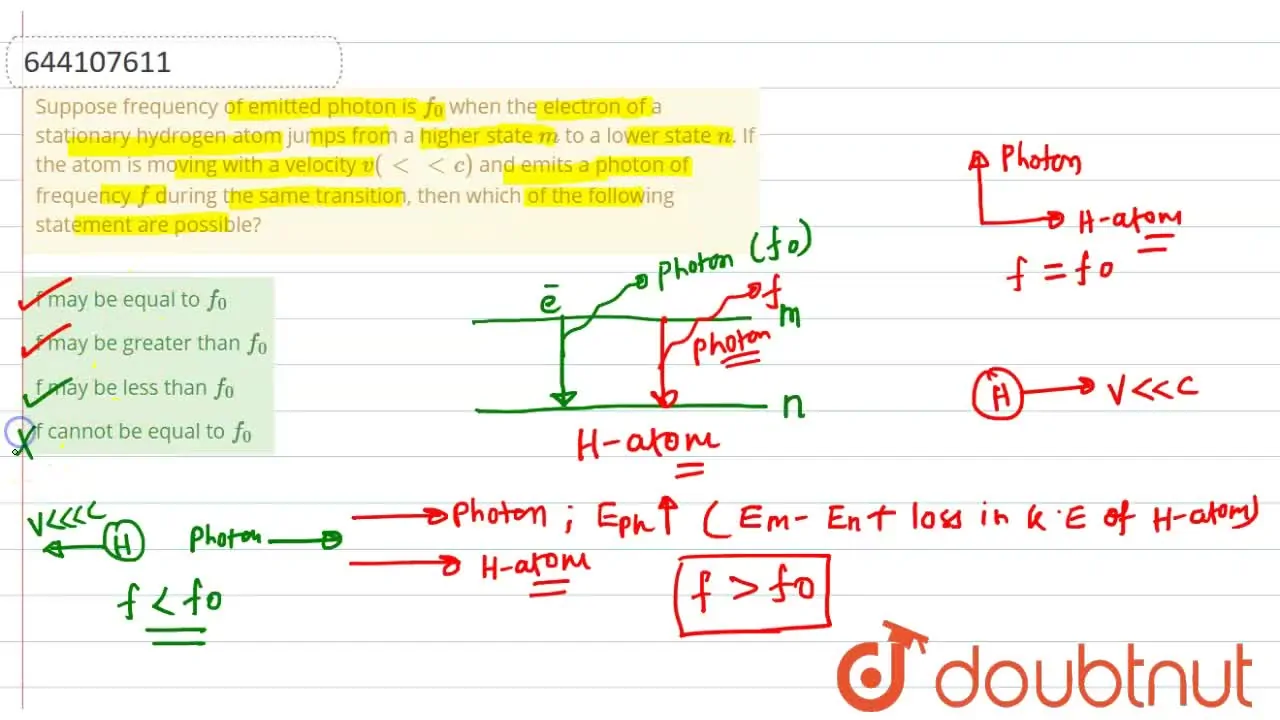Suppose frequency of emitted photon is f0 when the electron of a stationary hydrogen atom jumps from a higher state m to a lower state n. If the atom is moving with a velocity v(<<c) and emits a photon of frequency f during the same transition, then which of the following statement are possible?
f may be equal to f0
f may be greater than f0
f may be less than f0
f cannot be equal to f0
The correct Answer is:A, B, C
When a stationary hydrogen atom emits a photon, then energy of the emitted photon will be equal to the difference of the energy of the two levels involved in the transition. Hence, energy of emitted photon will be equal to (Em−En)
If a hydrogen atom is moving and a photon is emitted by it along the same direction in which it is moving , due to momentum of the emitted photon , the momentum of hydrogen atom will get decreased. Therefore energy of the emitted photon will be equal to (Em−En + "loss of KE of the hydrogen atom").
But if the photon is emitted in a direction normal to the motion, of the hydrogen atom, then the frequency of the emitted photon will be equal to f0. Hence, option (a) is correct, Obviously, option (d) is wrong.
If the photon is emitted by the hydrogen atom in the direction opposite to its motion, then frequency of the emitted photon will be less than f0. Hence, option (c) is correct.
Related Playlists
- BOOK - CENGAGE PHYSICS ENGLISHCHAPTER - ATOMIC PHYSICSEXERCISE - Multiple Correct13videos
ATOMIC PHYSICS
- BOOK - CENGAGE PHYSICS ENGLISHCHAPTER - ATOMIC PHYSICSEXERCISE - Linked Comprehension62videos
ATOMIC PHYSICS
- BOOK - CENGAGE PHYSICS ENGLISHCHAPTER - ATOMIC PHYSICSEXERCISE - Subject17videos
ATOMIC PHYSICS
- BOOK - CENGAGE PHYSICS ENGLISHCHAPTER - ALTERNATING CURRENTEXERCISE - Single Correct10videos
ALTERNATING CURRENT
- BOOK - CENGAGE PHYSICS ENGLISHCHAPTER - CAPACITOR AND CAPACITANCEEXERCISE - Integer5videos
CAPACITOR AND CAPACITANCE
Similar Questions
When the electron of a hydrogen atom jumps from the n=4 to the n=1 state , the number of all pos - sible spectral lines emitted is :-
View SolutionWhen the electron of a hydrogen atom jumps from the n=4 to the n=1 state , the number of all pos - sible spectral lines emitted is :-
View SolutionThe electron in a hydrogen atom makes a transition from an excited state to the ground state. Which of the following statements is true?
View SolutionThe electron in a hydrogen atom makes a transition from an excited state to the ground state. Which of the following statements is true?
View SolutionIf an electron in hydrogen atom jumps from third orbit to second orbit, the frequency of the emitted radiation is given by (c is speed of light )
View SolutionCalculate the two highest wavelength of the radiation emitted when hydrogen atoms make transition from higher state to n=2
View SolutionCalculate wavelength of photon emitted when an electron goes from n=3 to n=2 level of hydrogen atom.
View SolutionWhich of the following transitions in a hydrogen atom emits photon of the highest frequency ?
View SolutionIn hydrogen atom electron jumps from (n+1)th state to nth state the frequency of emitted photon is directly proportional to (n⟩>1)
View SolutionThe electron in a hydrogen atom at rest makes a transition from n=2 energy state to the n=1 ground state.
find the energy (eV) of the emitted photon.View Solution


